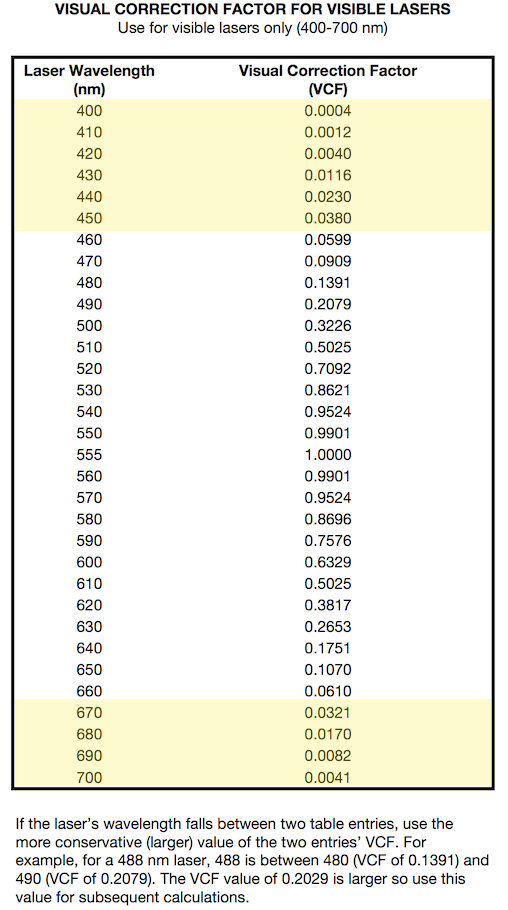THe Ophir Laser Power Density Calculator is a perfectly good tool for power distributed over an area given you know the laser power at the target. Really is just a calculation of W/cm squared for a circular area of whatever size you plug in.
NOHD and Flashblindness distances are very different. NOHD is a energy per cm squared calculation. NOHD does NOT depend on the wavelength-
Flashblindness distance is a human visual system phenomenon, a visual interference calculation that does depend on the wavelength.
NOHD is a calculation of W/cm squared laser power density same as the Ophir Laser Power Density calculator but also includes divergence. NOHD calculation takes into account how large the laser dot/spot will be at a given distance and what the beams power density is within the area of the dot/spot at a distance. It is a calculation of the distance where beam’s power density (irradiance) from the laser source drops below the Maximum Permissible Exposure limit of 2.54 milliwatts per square centimeter.
"NOHD is a standard laser safety concept. It expresses the “nominal” and not the actual distance at which a laser is deemed eye-safe. Keep in mind that the NOHD includes a safety factor of approximately 2/3. Example: for a 1 watt 1 milliradian visible laser with an NOHD of 733 feet, this means that under ideal conditions the laser has a 50% chance of causing a minimally detectable retinal lesion in the eye at 1/3 the NOHD distance, or 244 feet. The remaining 2/3 of the distance (489 feet) gives an additional safety factor. Obviously, the longer the distance from the laser, the lower the chance of eye injury. At 733 feet, there is essentially no chance of causing a retinal lesion in the eye"
See:
Laser Pointer Safety - Basic principles of laser beam hazards for aviation
FAA SZED is generally taken to be flashblindness distance.
Flashblindness distance needs a Visual Correction Factor to be calculated because human visual system has different sensitivity to different wavelengths.
FAA. See: SZED equation and Selected FAA Visual Correction Factors chart used in SZED calculations here:
Laser Pointer Safety - Laser hazard distance equations
Example of the difference--445nm blue laser -- "the NOHD and visual interference distances for a Spyder III Arctic laser. Using the actual output power of 800 mW and the manufacturer’s divergence of 1.5 milliradians for this laser, in calculations of NOHD and SZED the flashblindness distance of 384.9 feet is actually less than the eye hazard distance (NOHD) of 437.3 feet. This is because the human eye sees blue light poorly -- in this case, only 3% as well as the brightest green light."
This means as a real world practical matter that flashblinding with a 445nm blue laser can cause eye damage which is why 445nm blue lasers are not sold as "dazzlers" whereas 532nm green are.
Again from:
Laser Pointer Safety - Laser hazard distance equations
There are sophisticated dazzlers that incorporate a laser rangefinder and if they detect if an observer is within the NOHD shut the laser off but they are expensive. The advantage is the person using the dazzler does not need to know anything about NOHD or flashblindness or calculations for same.
"The laser rapidly determines if an unintended observer is within the nominal ocular hazard distance (NOHD) and immediately shuts off the glaring output to prevent accidental eye injury. Once the bystander has moved out of the NOHD, the laser output instantly resumes" From:
Maritime Security | GLARE LA-9/P | B.E. Meyers & Co., Inc.
It is interesting to note that the US Military dazzlers only have an output powers of 125mW, 200mW, and 250Mw.
What we are talking about here are dazzlers that are many times that output power and therefore are more dangerous and both NOHD and SZED distance are far larger.
See mW output specs. in BE Meyers catalog here:
http://bemeyers.com/wp-content/uploads/2013/04/BEMeyers-MicroCatalog-2014.pdf
PS While a little be obscure conceptually the real wrold calculations are all very simple mathematics, as follows:
NOHD (Nominal Ocular Hazard Distance) in feet = (32.8 ÷ milliradians) ✕ (square root of (0.5 ✕ milliwatts))
SZED (flashblindness distance) in feet = (32.8 ÷ milliradians) ✕ (square root of (12.7 ✕ milliwatts ✕ Visual Correction Factor for the wavelength you want an answer for))






